Image

ABSTRACT
The Longchang Apartments, which the British designed during the Shanghai Concession Period, is considered a building of great historical importance. However, the disconnected relationship between this historic building and the ever-developing modern society surrounding it becomes more and more evident over time. The backward living conditions of residents and management fail to meet contemporary needs, which intensifies various conflicts between different user groups within the historic site.
This thesis proposes a different way of living in high density within historic structures and explores a new program focusing on user groups’ behavior and interaction to activate the site. The adaptive reuse of Longchang Apartments re-organizes the interior according to programmatic requirements for privacy, and the inner courtyard is opened to the urban context as a public space that enhances a relaxing atmosphere and brings residents and visitors together through the outdoor cinema with a community cafe zone and a historical overview of the site.
As a response to the conditions required for the survival of historical buildings in contemporary society, integrating this historical building and heritage community with contemporary life helps the residents maintain an effective co-living environment. Simultaneously, the new openness provides visitors with more intuitive guidance through the building's new urban space to create a more harmonious open community environment.
ABOUT LONGCHANG APARTMENTS
The Longchang Apartments is located in Yangpu District, Shanghai. The building was designed by the British during the Shanghai Concession Period, which is under the charge of The Shanghai International Settlement in the early 19th Century.
There were 14 district patrol houses under the Shanghai Public Concession Patrol House. Yangshupu Patrol House was one of them. Longchang apartments was once the staff dormitory of Yangshupu Patrol House, which is now a residential complex for rental.
Image

▲ Site Location
With the development of history, this building has different identities in different periods of time.
The building was once the staff dormitory of Yangshupu Patrol House which was the attached building next door. Nowadays, Longchang apartments no longer serves the police department, so the use of the building is no longer restricted. Some of the original residents still stay here, and the others are migrant workers who moved in because of low rent and convenient location.
In 2004 it was listed as a heritage architecture in Shanghai under the category of "Residence".
Image
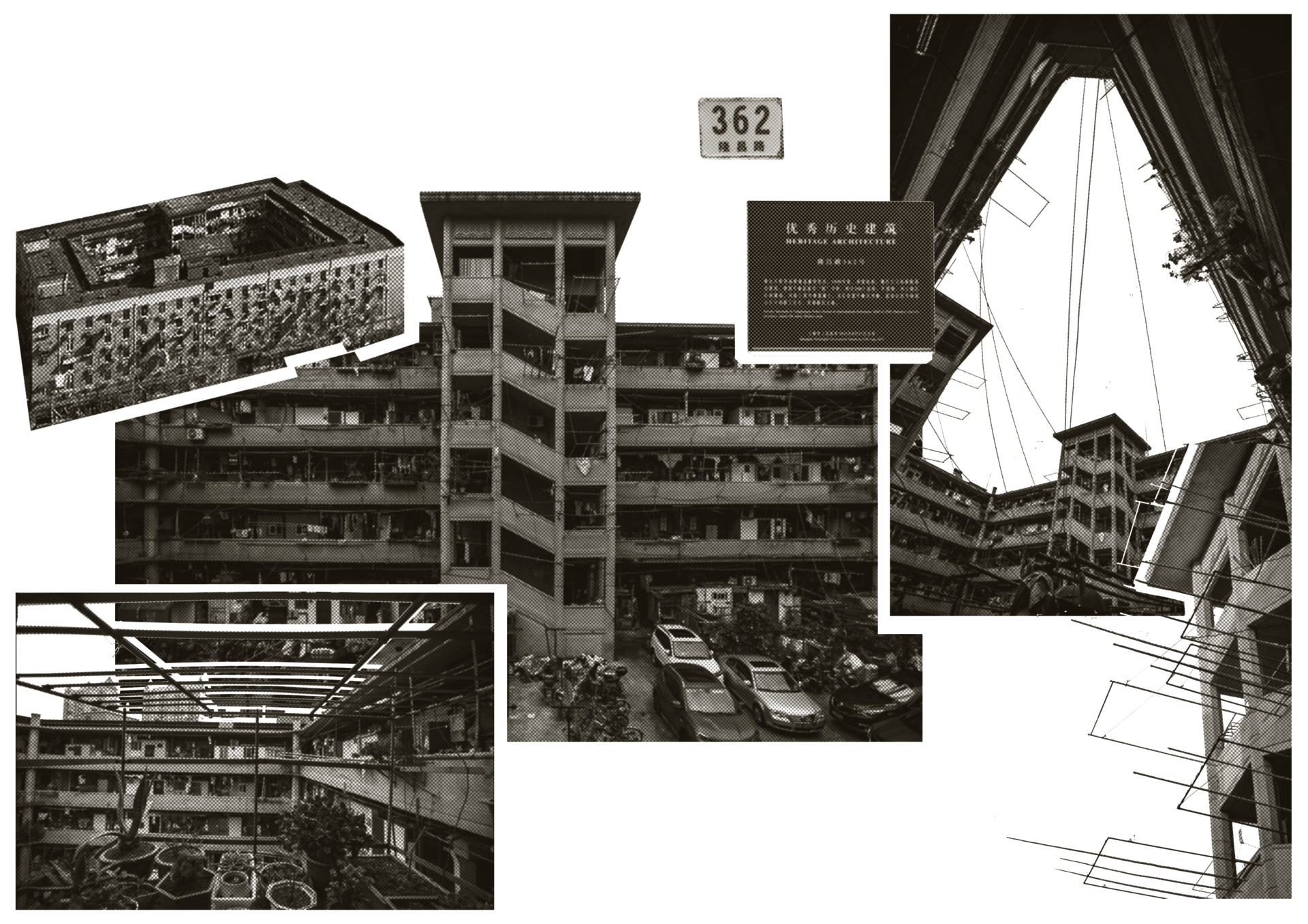
▲ Current status of Longchang Apartments
Image

▲ Timeline of Longchang Apartments
When Longchang Apartments was completed in the 1930s, the north-east side of the courtyard is not used for accommodation. Still, it is used for public facilities, such as canteen, boiler room, laundry room, clothes drying room, restroom, bathroom, medical and health room, etc., for all the residents to use.
Each unit originally only accommodated one household but was changed to accommodate two households after 1949. In order to provide more living space with continuously increasing residents, many public facilities like the shared kitchen and laundry room were demolished and converted into residential units, therefore after the 1980s, resulting in small spaces and densely packed units. Residents started to build houses and occupy spaces in the corridors and staircases to expand their living area. This marked the apartment corridors extraordinarily narrow, allowing only one person to pass through.
Image
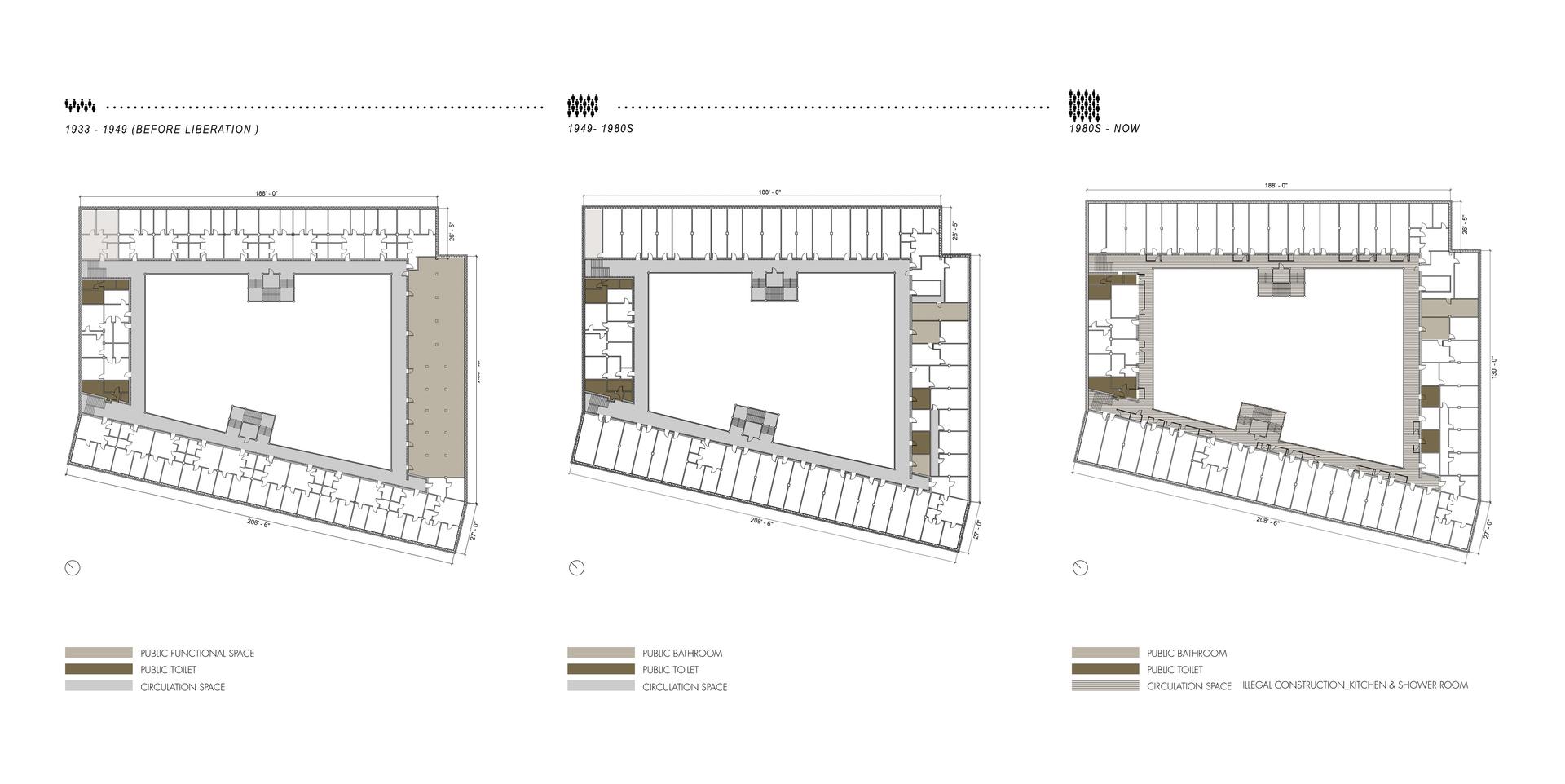
▲ Changes of layout in the historical evolution
EXISTING PROBLEMS
Image
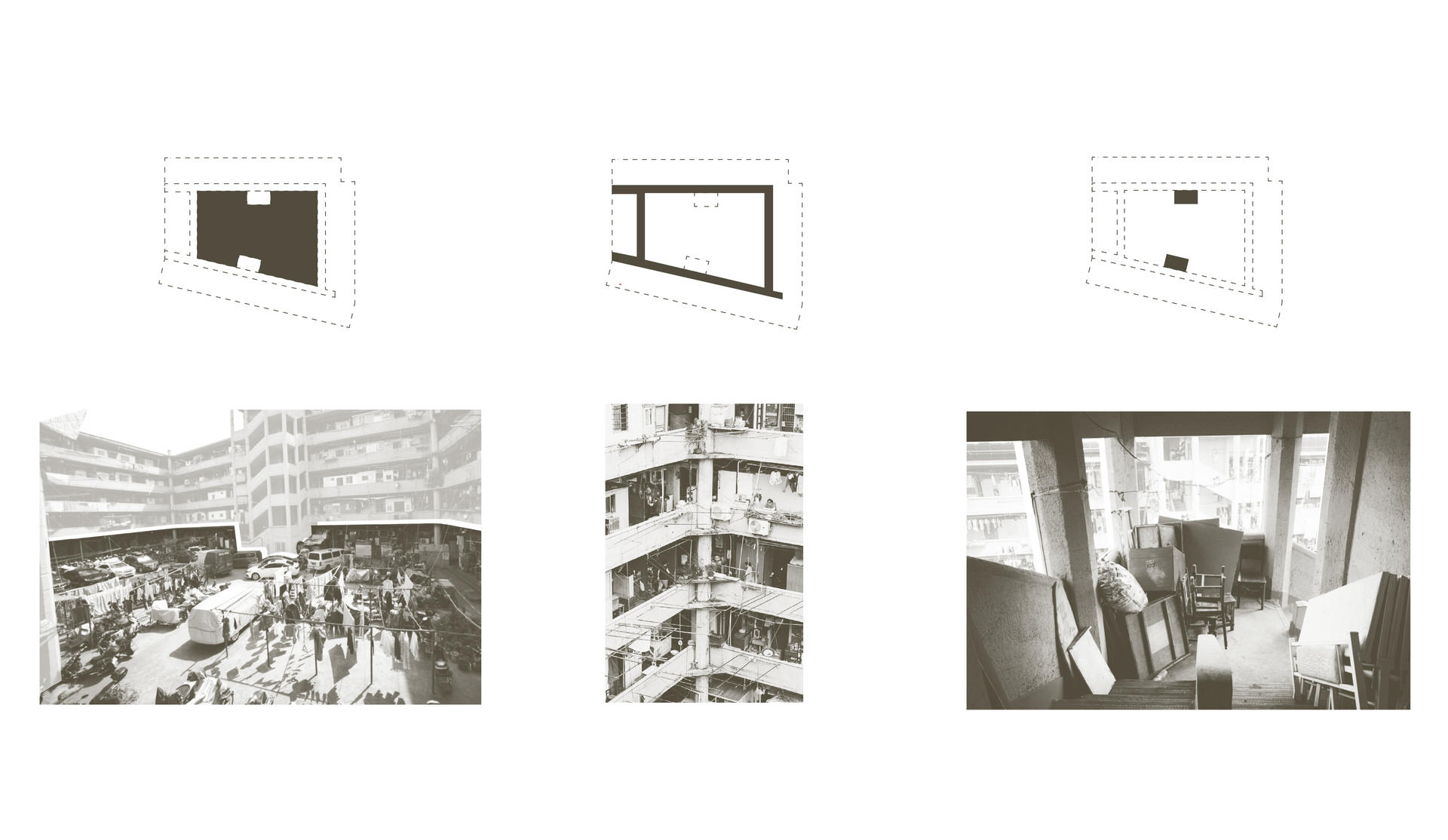
▲ The phenomenon of residents spontaneously occupying public spaces
There is no obvious distinction in the public space. The boundary of the private area mostly extends the occupancy of the public space by residents. The shared resources in public spaces are measured in an evenly shared manner. When the definition of public space and resources in the residents' hearts is biased with the actual situation, conflicts can easily happen.
Residents' spontaneous privatization of public areas also makes it impossible to guarantee the privacy of these spaces. The daily lives of residents are mixed in these public spaces. This uncommon life scene in contemporary society and the original reputation of the building attract more and more visitors to come. The lives of the residents have been affected but there is no suitable way to improve this phenomenon and protect the privacy of residents’ lives.
DESIGN CONCEPT
Image
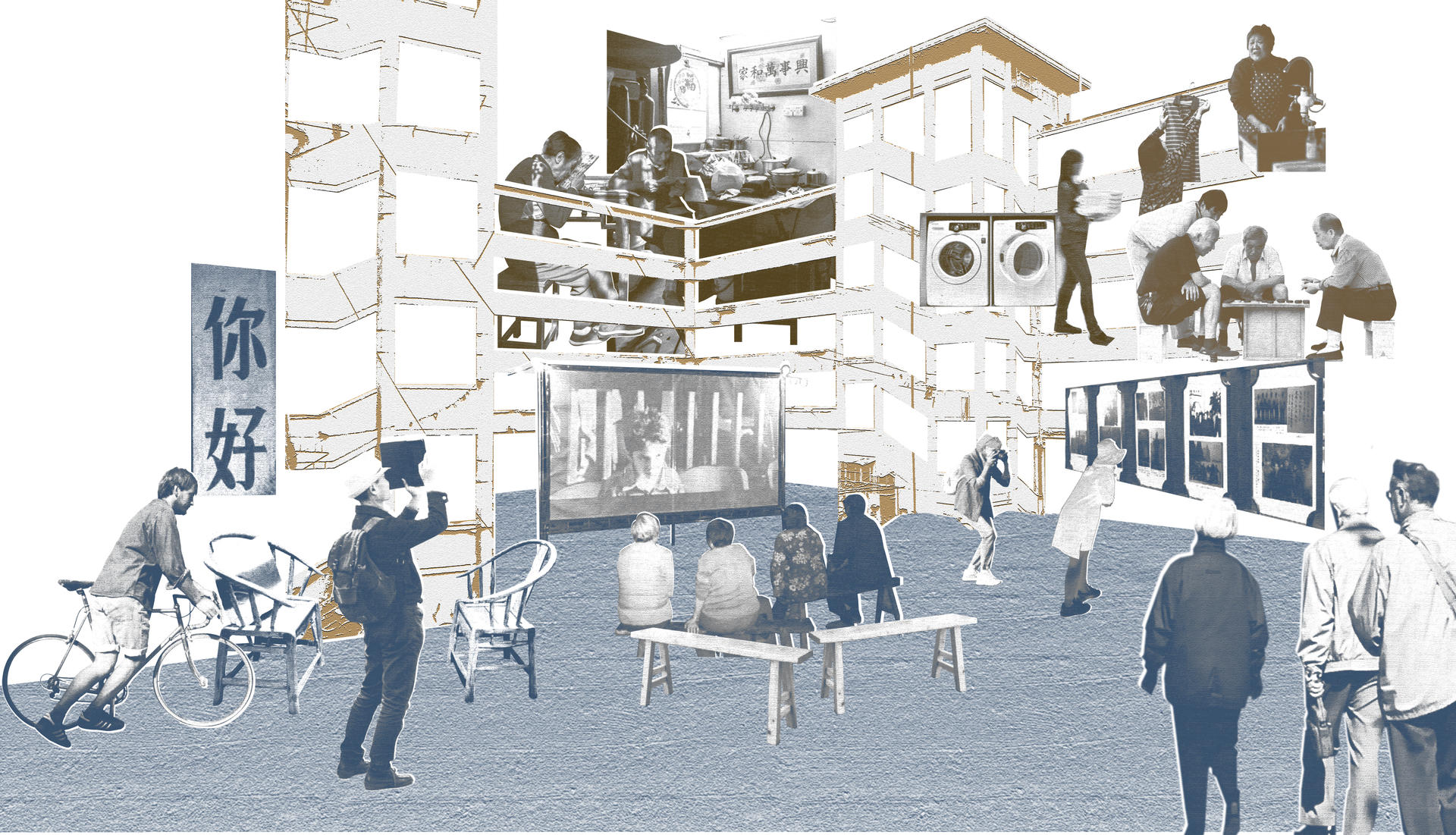
Based on the analysis of the current situation, the user group's behavior and interaction are essential contents to be referred to in the design. The direction of residents' needs and the guiding role of space are always complementary to each other.
In this particular building of Longchang Apartment, residents are the main user group, which can be regarded as a "fixed" group. Their needs are the main entry point for activating this historical community; the visitor group is considered as an "incidental" group. The existence of them in the current state of the building space has an adverse impact on the lives of residents. Therefore, the main content of design is to reorganize the space and function division of the building and create the spatial boundary between different user groups.
Image
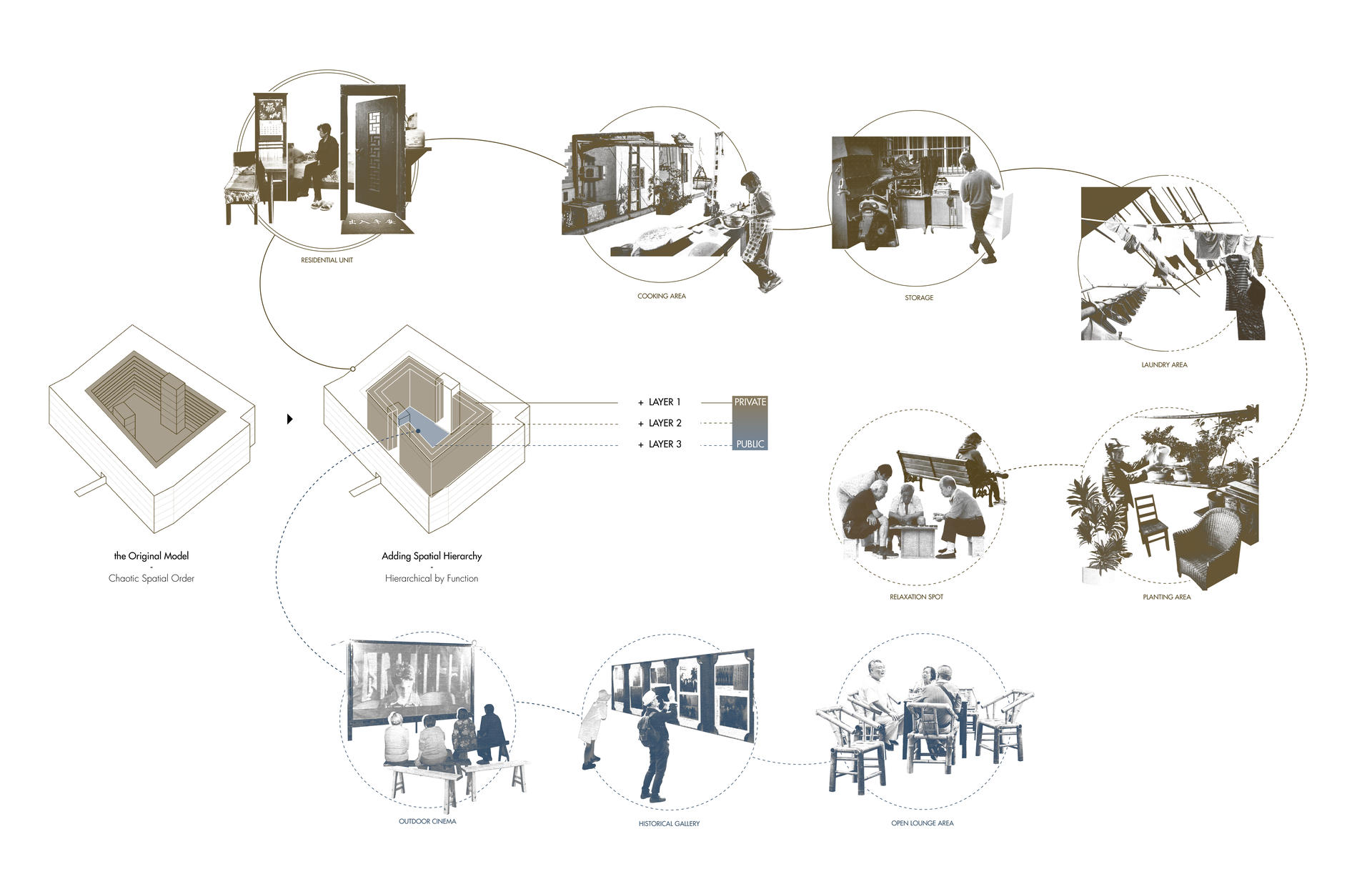
CONCEPT EVOLUTION
Image
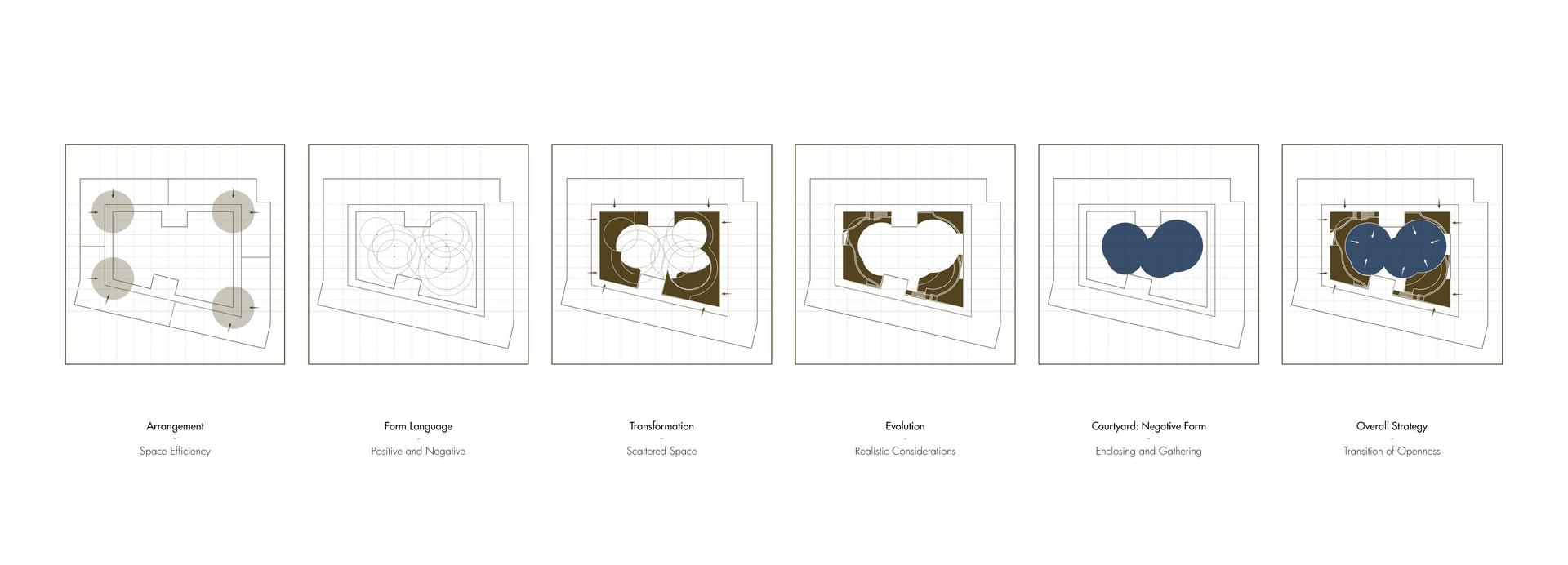
DESIGN CONTENT
Image
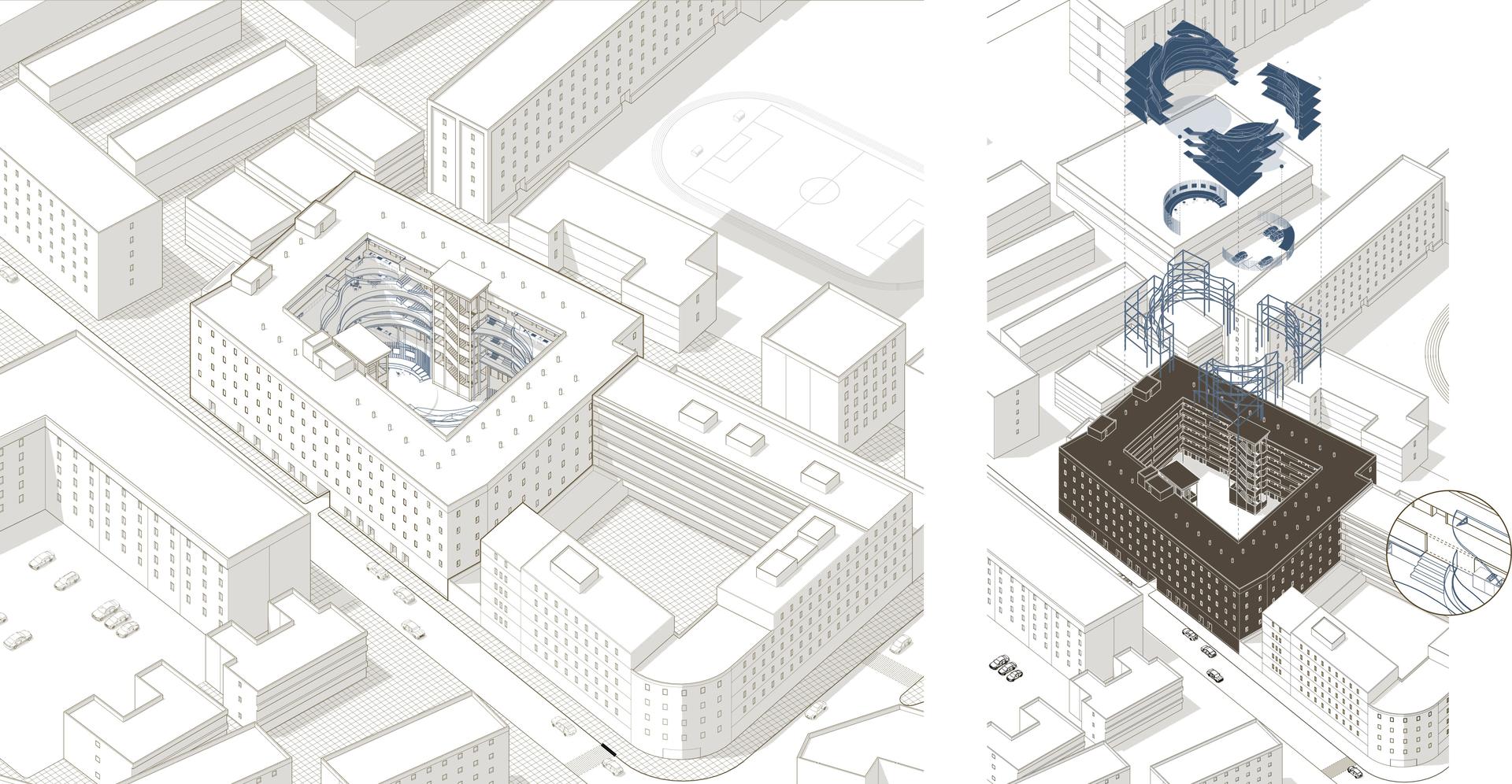
▲ Axonometric and Exploded View
The renovated contents are limited in the courtyard space to keep as much original construction as possible.
In the exploded view, the newly added layers are shown clearly, the first and second layers extended from the building and the third layer in the courtyard. The only demolished elements within the heritage building are some parts of the handrails, those cut are giving entrance from the original corridor to the new design.
Image
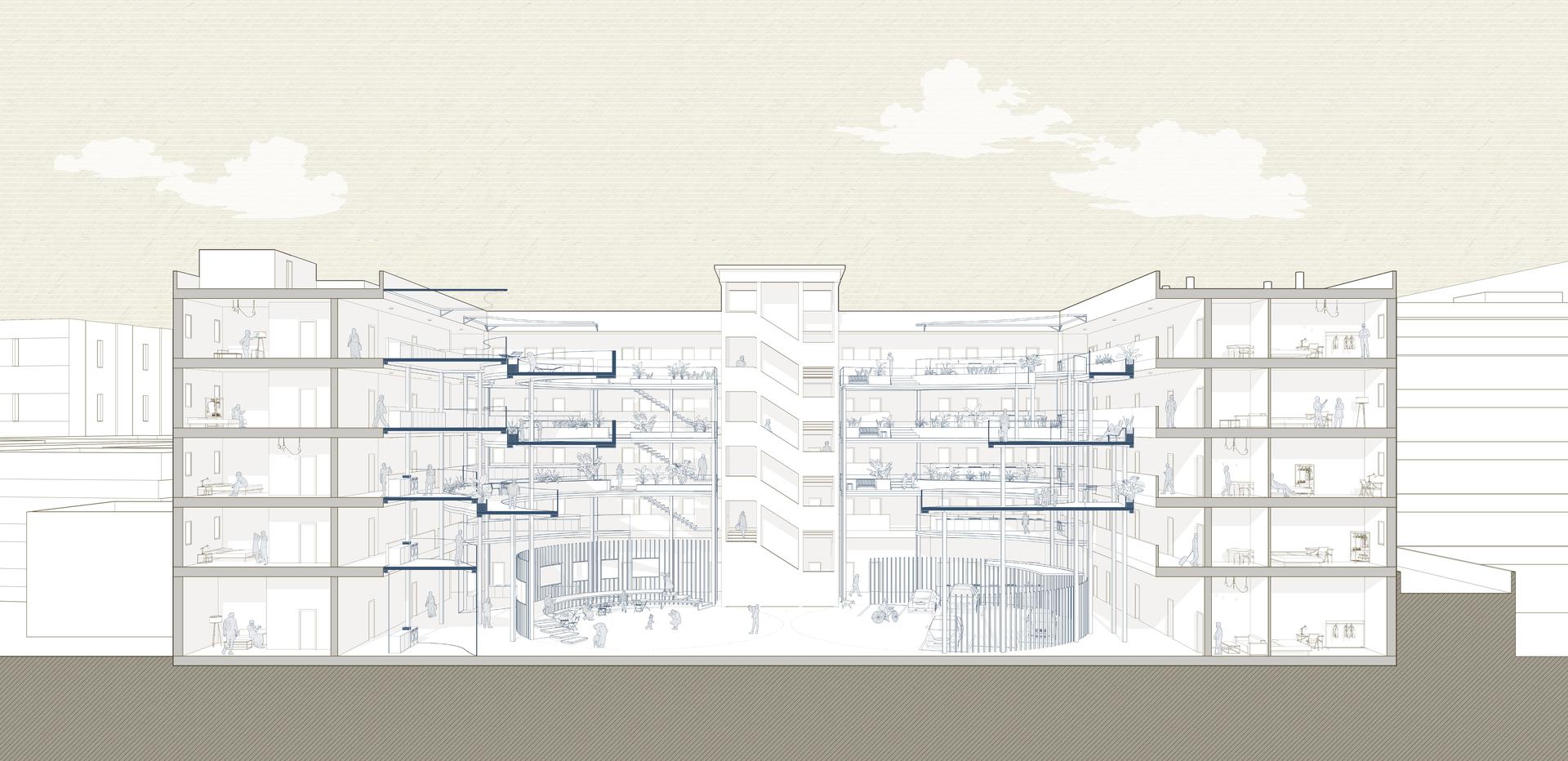
▲ Section Perspective
Image
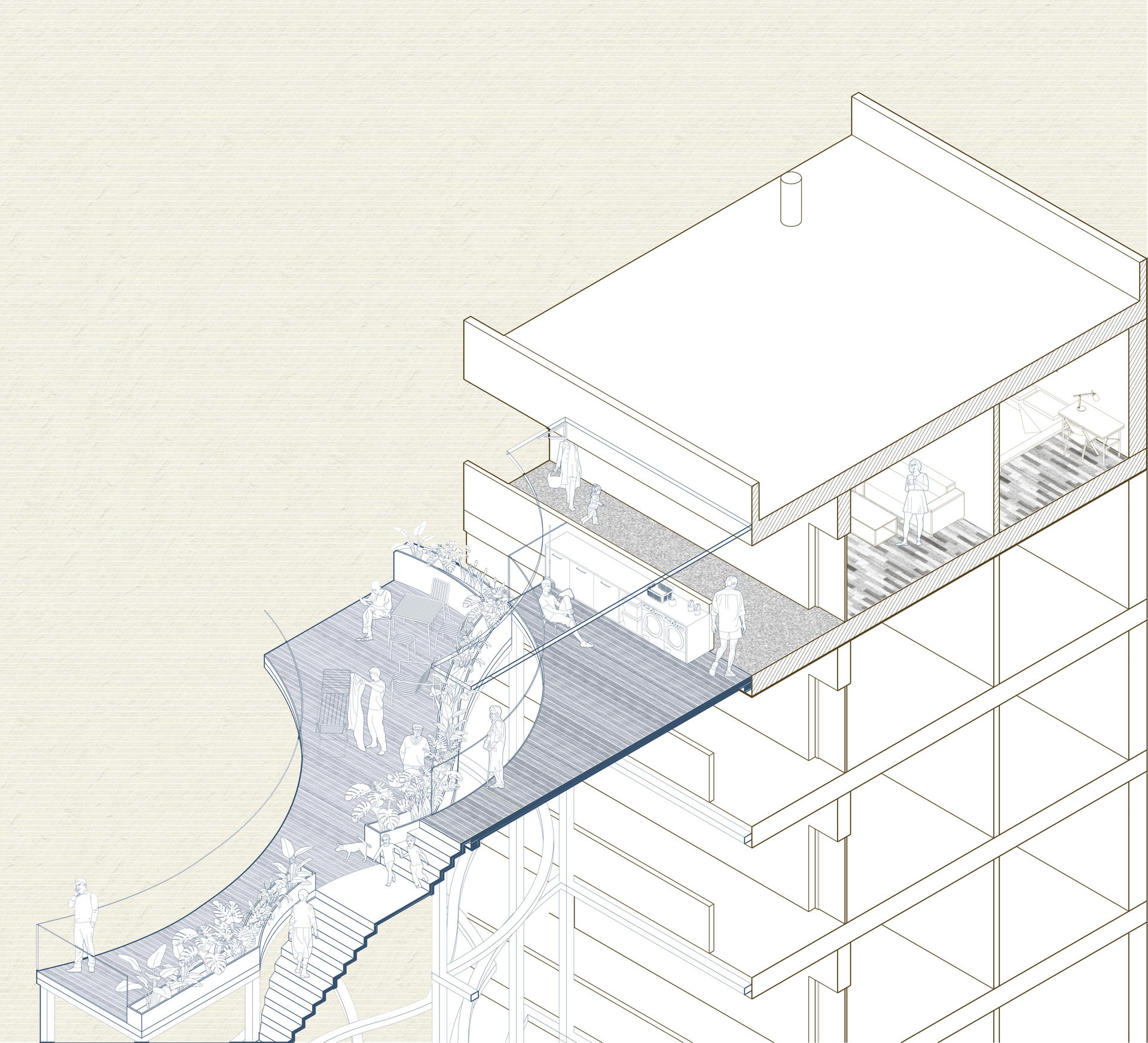
▲ Partial axonometric section showing transition between various layers
The partial section shows the transition between various layers. From the private residential units of the old building to the corridor, then to layer 1 that carries the shared laundry and kitchen functions.
layer 2 which is the balcony layer is at a level lower than layer 1 and can be reached from two adjacent floors above and below. At the same time, the height difference together with the layout of the planting pots gives the two layers a soft partition.
Image
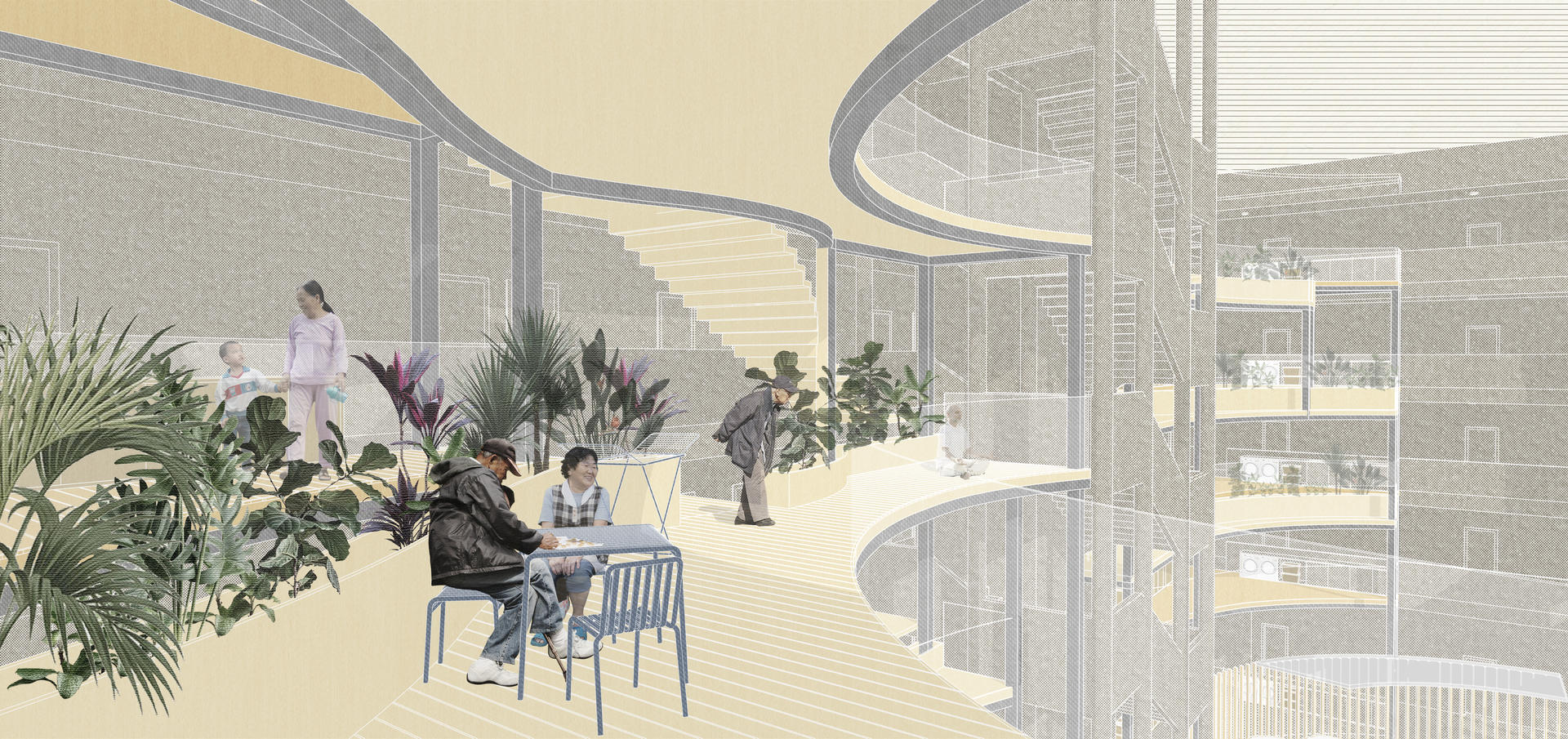
▲ Residents' vision standing on layer2(the extended balcony layer)
Image
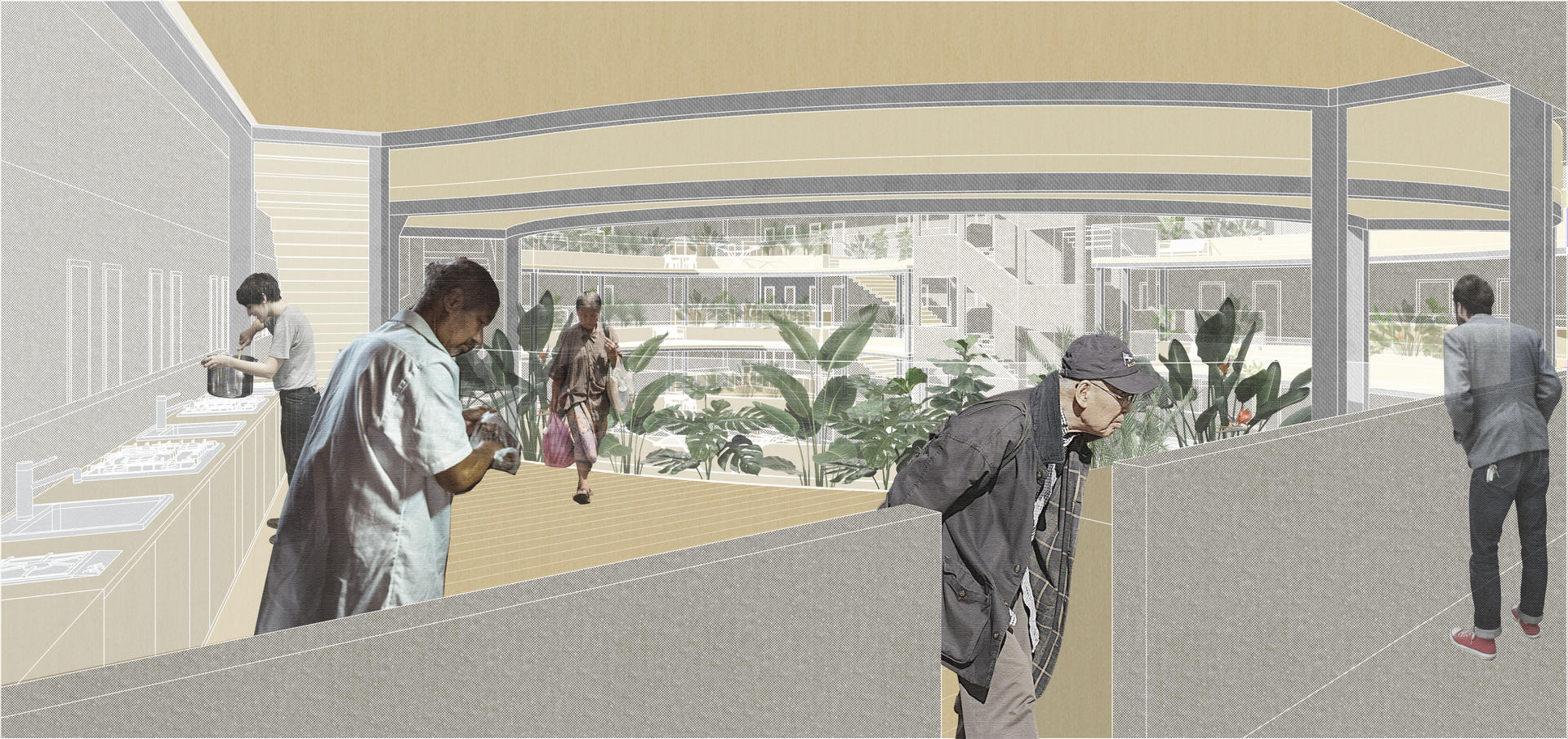
▲ Residents' vision standing in the original corridor
Layer 3 is the most open layer on the ground floor of the courtyard. It is divided into two parts, one is an activity space for people which is designed as a semi-closed overall structure. Contains a historical gallery about the building and related history, leisure seating area. This area can be used for community activities and as an open-air movie area. It is like a living room of the community, providing visitors with a reasonable activity area instead of shutting them out.
The second part is for the existing parking function, with the same space but reorganized.
Image

Image
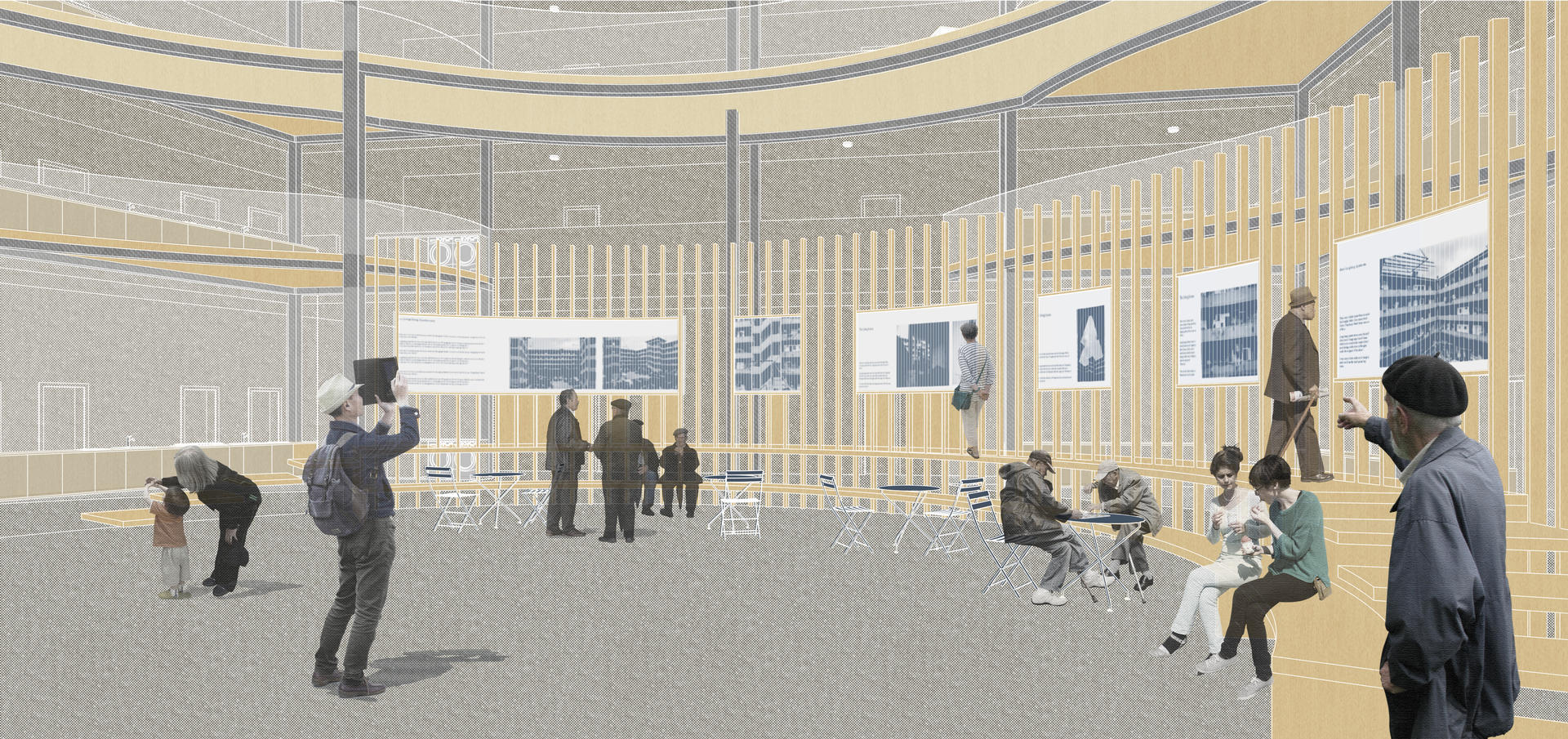
▲ View of the courtyard activity zone
ANNONTATED BIBLIOGRAPHY
- Verein Ein Haus WOBA, WOBA 1930, 2018
https://ein-haus-woba.ch/en/woba-1930/
This link is about one of the case studies of the typology. Apartments of WOBA Basel is one of the first typical practices of the "Houses with Balcony Access" as affordable housing in Europe. It is a background study on the history and evolution of this type of housing in China.
- Fei, Chengkang, "History of Chinese Concessions", Shanghai Academy of Social Sciences Press, Oct.1991.
The historical background of the base is in the Shanghai concession period when the social situation at that time is directly related to the design and architecture of the building. Different historical periods brought changes to the organization of the building and the identities of the user group. This article introduces the history of the Shanghai concession period and helps understand the building in combination with the historical evolution.
- Fotoeins, Fotoeins Friday: Dessau Balcony-Access Apartments (Bauhaus100), Apr. 2019
https://fotoeins.com/2019/04/26/fotoeins-friday-dessau-balconyapts-toer…
Dessau Balcony-Access Apartments is a precedent of the "Houses with Balcony Access" typology. This building is a case of Bauhaus's initial attempt to solve the housing problem with verticality and standardization.
- JingPingWenyi, Overseas design in the history of modern Chinese architecture[J]. 2006(05).
The site is a residential building designed by the British during the Shanghai Concession Period, which is one of the first cases of Western architectural forms being practiced in China. At the same time, many similar overseas buildings appeared in the concession cities represented by Shanghai. This article introduces the relationship between history and architecture.
- Li, Bieshui,每栋筒子楼的背后都藏着包豪斯的影子,2019
After "Houses with Balcony Access" entered China, it was localized as "Tongzilou"(筒子楼). Bauhaus initiated this kind of architectural style. However, in China, the typology was gradually localized with spontaneous building use behaviors such as the privatization of public spaces.
- Tang, Fang. Architectural Control—Research on the Building Regulations of Modern Shanghai Public Concessions, Jun.2006.
This thesis is about the control and regulation of concession buildings. The overseas architectural form and local regulations and requirements jointly limit the final design of the building.
- Yang, Feng, Research on Longchang Apartment in Shanghai Revisiting the Transformation of Old-fashioned Residential Forms, 上海隆昌公寓研究:在看老式居住形态转型, 时代建筑,2016.
This article mainly introduces the use of the building in contemporary society, including detailed descriptions of existing facilities and occupancy patterns of public areas, which involve the "growth" of illegal constructions in the building.
